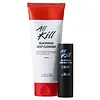What's inside
What's inside
 Key Ingredients
Key Ingredients

 Benefits
Benefits

 Concerns
Concerns

 Ingredients Side-by-side
Ingredients Side-by-side

Water
Skin ConditioningStearic Acid
CleansingGlycerin
HumectantLauric Acid
CleansingPotassium Hydroxide
BufferingMyristic Acid
CleansingGlyceryl Stearate
EmollientPEG-100 Stearate
Cocamidopropyl Betaine
CleansingPEG-8
HumectantPolyquaternium-7
Polysorbate 20
EmulsifyingHydroxyethylcellulose
Emulsion StabilisingSodium Chloride
MaskingCitrus Junos Seed Oil
EmollientSaponaria Officinalis Leaf Extract
AntimicrobialButylene Glycol
HumectantTocopheryl Acetate
AntioxidantCI 19140
Cosmetic ColorantPhenoxyethanol
PreservativeParfum
MaskingWater, Stearic Acid, Glycerin, Lauric Acid, Potassium Hydroxide, Myristic Acid, Glyceryl Stearate, PEG-100 Stearate, Cocamidopropyl Betaine, PEG-8, Polyquaternium-7, Polysorbate 20, Hydroxyethylcellulose, Sodium Chloride, Citrus Junos Seed Oil, Saponaria Officinalis Leaf Extract, Butylene Glycol, Tocopheryl Acetate, CI 19140, Phenoxyethanol, Parfum
Water
Skin ConditioningSodium Stearate
CleansingPropylene Glycol
HumectantMethylpropanediol
SolventCharcoal Powder
AbrasiveBis-PEG-18 Methyl Ether Dimethyl Silane
EmollientSilica
AbrasivePolysorbate 20
EmulsifyingMicrocrystalline Cellulose
AbsorbentLactose
HumectantBentonite
AbsorbentJuglans Regia Shell Powder
AbrasiveCellulose
AbsorbentVitis Vinifera Fruit Extract
Skin ConditioningDiospyros Kaki Leaf Extract
Skin ProtectingPolygonum Cuspidatum Root Extract
AntioxidantCoffea Arabica Seed Extract
MaskingCarthamus Tinctorius Flower Extract
Skin ConditioningZanthoxylum Schinifolium Leaf Extract
Skin ConditioningCastanea Crenata Shell Extract
Skin ConditioningCamellia Sinensis Leaf Extract
AntimicrobialCitrus Aurantium Dulcis Fruit Extract
MaskingPyrus Malus Fruit Extract
Skin ConditioningCitrus Limon Fruit Extract
MaskingCitrus Aurantifolia Fruit Extract
Skin ConditioningOryza Sativa Extract
AbsorbentGlycine Soja Seed Extract
Skin ConditioningSesamum Indicum Seed Extract
Skin ConditioningMelaleuca Alternifolia Leaf Extract
PerfumingAloe Ferox Leaf Extract
Skin ConditioningChamomilla Recutita Extract
Skin ConditioningLavandula Angustifolia Flower Extract
CleansingJojoba Esters
EmollientButylene Glycol
HumectantHydroxypropyl Methylcellulose
Emulsion StabilisingAscorbyl Palmitate
AntioxidantSodium Hyaluronate
HumectantCitric Acid
BufferingAscorbic Acid
AntioxidantBetaine Salicylate
AntimicrobialSalicylic Acid
MaskingGluconolactone
Skin ConditioningEthylhexylglycerin
Skin Conditioning1,2-Hexanediol
Skin ConditioningTocopheryl Acetate
AntioxidantChlorphenesin
AntimicrobialPhenoxyethanol
PreservativeCI 73360
Cosmetic ColorantParfum
MaskingWater, Sodium Stearate, Propylene Glycol, Methylpropanediol, Charcoal Powder, Bis-PEG-18 Methyl Ether Dimethyl Silane, Silica, Polysorbate 20, Microcrystalline Cellulose, Lactose, Bentonite, Juglans Regia Shell Powder, Cellulose, Vitis Vinifera Fruit Extract, Diospyros Kaki Leaf Extract, Polygonum Cuspidatum Root Extract, Coffea Arabica Seed Extract, Carthamus Tinctorius Flower Extract, Zanthoxylum Schinifolium Leaf Extract, Castanea Crenata Shell Extract, Camellia Sinensis Leaf Extract, Citrus Aurantium Dulcis Fruit Extract, Pyrus Malus Fruit Extract, Citrus Limon Fruit Extract, Citrus Aurantifolia Fruit Extract, Oryza Sativa Extract, Glycine Soja Seed Extract, Sesamum Indicum Seed Extract, Melaleuca Alternifolia Leaf Extract, Aloe Ferox Leaf Extract, Chamomilla Recutita Extract, Lavandula Angustifolia Flower Extract, Jojoba Esters, Butylene Glycol, Hydroxypropyl Methylcellulose, Ascorbyl Palmitate, Sodium Hyaluronate, Citric Acid, Ascorbic Acid, Betaine Salicylate, Salicylic Acid, Gluconolactone, Ethylhexylglycerin, 1,2-Hexanediol, Tocopheryl Acetate, Chlorphenesin, Phenoxyethanol, CI 73360, Parfum
Ingredients Explained
These ingredients are found in both products.
Ingredients higher up in an ingredient list are typically present in a larger amount.
Butylene Glycol (or BG) is used within cosmetic products for a few different reasons:
Overall, Butylene Glycol is a safe and well-rounded ingredient that works well with other ingredients.
Though this ingredient works well with most skin types, some people with sensitive skin may experience a reaction such as allergic rashes, closed comedones, or itchiness.
Learn more about Butylene GlycolParfum is a catch-all term for an ingredient or more that is used to give a scent to products.
Also called "fragrance", this ingredient can be a blend of hundreds of chemicals or plant oils. This means every product with "fragrance" or "parfum" in the ingredients list is a different mixture.
For instance, Habanolide is a proprietary trade name for a specific aroma chemical. When used as a fragrance ingredient in cosmetics, most aroma chemicals fall under the broad labeling category of “FRAGRANCE” or “PARFUM” according to EU and US regulations.
The term 'parfum' or 'fragrance' is not regulated in many countries. In many cases, it is up to the brand to define this term.
For instance, many brands choose to label themselves as "fragrance-free" because they are not using synthetic fragrances. However, their products may still contain ingredients such as essential oils that are considered a fragrance by INCI standards.
One example is Calendula flower extract. Calendula is an essential oil that still imparts a scent or 'fragrance'.
Depending on the blend, the ingredients in the mixture can cause allergies and sensitivities on the skin. Some ingredients that are known EU allergens include linalool and citronellol.
Parfum can also be used to mask or cover an unpleasant scent.
The bottom line is: not all fragrances/parfum/ingredients are created equally. If you are worried about fragrances, we recommend taking a closer look at an ingredient. And of course, we always recommend speaking with a professional.
Learn more about ParfumPhenoxyethanol is a preservative that has germicide, antimicrobial, and aromatic properties. Studies show that phenoxyethanol can prevent microbial growth. By itself, it has a scent that is similar to that of a rose.
It's often used in formulations along with Caprylyl Glycol to preserve the shelf life of products.
Polysorbate 20 is made by combining ethoxylation of sorbitan, ethylene oxide, and lauric acid. It is a mild cleansing agent, surfactant, and emulsifier.
As a surfactant, it helps collect dirt and oils for washing. Emulsifiers prevent oils and water from separating.
Polysorbate 20 also adds scent to a product. Since it is made using sorbitol, it has a sweet scent. Sorbitol can also be found in fruits such as apples and peaches.
The lauric acid used to create Polysorbate 20 is often derived from coconuts.
Polysorbate 20 may not be fungal acne safe.
Learn more about Polysorbate 20Tocopheryl Acetate is AKA Vitamin E. It is an antioxidant and protects your skin from free radicals. Free radicals damage the skin by breaking down collagen.
One study found using Tocopheryl Acetate with Vitamin C decreased the number of sunburned cells.
Tocopheryl Acetate is commonly found in both skincare and dietary supplements.
Learn more about Tocopheryl AcetateWater. It's the most common cosmetic ingredient of all. You'll usually see it at the top of ingredient lists, meaning that it makes up the largest part of the product.
So why is it so popular? Water most often acts as a solvent - this means that it helps dissolve other ingredients into the formulation.
You'll also recognize water as that liquid we all need to stay alive. If you see this, drink a glass of water. Stay hydrated!
Learn more about Water